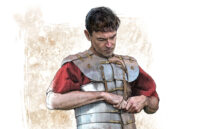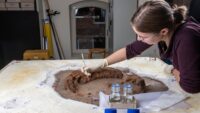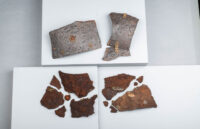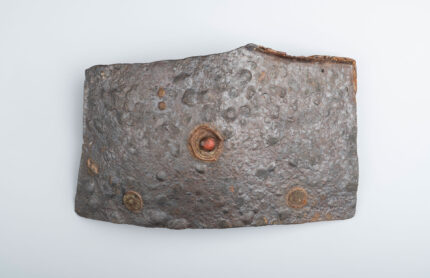Skip to comments.
Oldest Roman body armour found in Germany
The History Blog ^
| September, 2020
Posted on 10/24/2020 2:34:48 PM PDT by LibWhacker
Oldest Roman body armour found in Germany
 Archaeologists have discovered the oldest and most complete Roman body armour at the site of the Battle of the Teutoburg Forest in Kalkriese, Germany. Before this find, the earliest known examples of Roman lorica segmentata — iron plate sections tied together — were found in Corbridge, UK, and date to the 2nd century. Those were fragments. The Kalkriese armor is a complete set, and includes an extremely rare iron collar used to shackle prisoners.
Archaeologists have discovered the oldest and most complete Roman body armour at the site of the Battle of the Teutoburg Forest in Kalkriese, Germany. Before this find, the earliest known examples of Roman lorica segmentata — iron plate sections tied together — were found in Corbridge, UK, and date to the 2nd century. Those were fragments. The Kalkriese armor is a complete set, and includes an extremely rare iron collar used to shackle prisoners.
More than 7,000 objects have been found at the Kalkriese battlefield site, from weapons to coins to items of everyday use. In the summer of 2018, a metal detector scan of the side wall of an excavation trench retuned 10 strong signals, indications of a large quantity of metal inside the bank. To ensure whatever was in there wasn’t exposed to the air and rapid oxidization, archaeologists removed the entire soil block containing the mystery metallics.
The first step was to scan the block to see what was inside and map out its excavation. The block was too big for regular X-ray machines, so they transported the crate to the Münster Osnabrück International Airport where the customs office has a freight-sized X-ray machine. All they could see was nails of the wooden crate and a large black hole in the shape of the soil block.
In 2019, it was sent to the Fraunhofer Institute in Fürth which has the world’s largest CT scanner — a circular platform more than 11 feet in diameter that rotates while the X-ray apparatus moves up and down — more than big enough for the crate to fit and powerful enough to see inside the dense soil block. The scan revealed the remains of a cuirass — the section of a lorica segmentata where the breastplate and back plate are buckled together. The plates of the armour were pushed together like an accordion by the weight of the soil pressing on down them for 2,000 years.
Here’s a nifty digital animation by the Fraunhofer Institute generated from the CT scan data that reveals the armour inside the soil block.
 Armed with the detailed scans, restorers were able to begin excavation of the soil block. They found that despite Kalkriese’s highly acidic sandy soil, the armour is relatively well-preserved. There is extensive corrosion of the mental, but the set is uniquely complete with hinges, buckles, bronze bosses and even extremely rare surviving pieces of the leather ties. The plates from the shoulder and chest have been recovered and restored. The belly plates are still in the soil block. There are no arm plates in this early design.
Armed with the detailed scans, restorers were able to begin excavation of the soil block. They found that despite Kalkriese’s highly acidic sandy soil, the armour is relatively well-preserved. There is extensive corrosion of the mental, but the set is uniquely complete with hinges, buckles, bronze bosses and even extremely rare surviving pieces of the leather ties. The plates from the shoulder and chest have been recovered and restored. The belly plates are still in the soil block. There are no arm plates in this early design.
 Iron plate armour was introduced by Augustus as an improvement on chain mail. It was relatively light (around 17 pounds) and because the plates were tied together with leather cords, they were much more flexible than chain mail. so it was the latest and greatest technology in 9 A.D. when Publius Quinctilius Varus blundered into a German ambush that obliterated three full Roman legions plus their auxiliaries.
Iron plate armour was introduced by Augustus as an improvement on chain mail. It was relatively light (around 17 pounds) and because the plates were tied together with leather cords, they were much more flexible than chain mail. so it was the latest and greatest technology in 9 A.D. when Publius Quinctilius Varus blundered into a German ambush that obliterated three full Roman legions plus their auxiliaries.
The legionary who wore this armour apparently survived the battle because around his neck/shoulder area was a shrew’s fiddle, also known as a neck violin. This was an iron collar connected to two handcuffs that locked a prisoner’s hands in front of his neck. The Romans used them to shackle prisoners destined for slavery. This time the tables were turned, and the soldier died in shackles.
The restoration is ongoing and is expected to take another two years. Once it’s complete, the armour will go on display in an exhibition at the Kalkriese Museum and Park.

TOPICS: History; Military/Veterans; Science
KEYWORDS: armor; germany; godsgravesglyphs; kalkriese; oldest; romanbaltic; romanempire; romangermany; rome; teutoberg; teutobergforest; teutoburg
Navigation: use the links below to view more comments.
first 1-20, 21-40, 41-50 next last
Love this armor.
Click images to magnify.
There's also a little 2-min video at the source.
To: LibWhacker
Lorica Segmentata was centuries ahead of it’s time.
Probably would have been superior to what Western Europe used even in 1000 AD.
This is an amazing find!
2
posted on
10/24/2020 2:40:19 PM PDT
by
Roman_War_Criminal
(Jesus + Something = Nothing ; Jesus + Nothing = Everything)
To: LibWhacker
I should say cool little 2-min video.
To: LibWhacker
For Sale: Used armor, only one owner, slight odor
4
posted on
10/24/2020 2:42:27 PM PDT
by
Rurudyne
(Standup Philosopher)
To: Roman_War_Criminal
centuries ahead of it’s time Yep, very modern look to it. Probably why I like it so much.
To: LibWhacker
The legionary who wore this armour apparently survived the battle because around his neck/shoulder area was a shrew’s fiddle, also known as a neck violin.He didn't survive for long if he died in his armor and his body was left on the battlefield. The question is why the Germans would have bothered shackling him before killing him. Or perhaps he was wounded, taken prisoner, shackled but then died of his wounds.
6
posted on
10/24/2020 2:44:22 PM PDT
by
sphinx
To: LibWhacker
>There is extensive corrosion of the mental
That’s not Roman. That’s Democrat.
To: LibWhacker
Click images to magnify. Click a second time to zoom in even more.
To: LibWhacker
 The Adventures of Brisco County, Jr. "Ned Zed" episode is based on the 19th century Australian outlaw Ned Kelly. He was famous for building himself and his bunch armors for being immune against bullets. At the end he got shot several times in his legs, because the armor only covered his head and upper body.
The Adventures of Brisco County, Jr. "Ned Zed" episode is based on the 19th century Australian outlaw Ned Kelly. He was famous for building himself and his bunch armors for being immune against bullets. At the end he got shot several times in his legs, because the armor only covered his head and upper body.
9
posted on
10/24/2020 2:49:00 PM PDT
by
\/\/ayne
(I regret that I have but one subscription cancellation notice to give to my local newspaper)
To: LibWhacker
10
posted on
10/24/2020 2:51:21 PM PDT
by
thesearethetimes...
(Had I brought Christ with me, the outcome would have been different. Dr.Eric Cunningham)
To: LibWhacker
Just in time for that new Netflix series Barbaren.
To: sphinx; LibWhacker
Doesn’t make sense. Why would a prisoner be left in armor at all?
To: LibWhacker; SunkenCiv
13
posted on
10/24/2020 2:56:21 PM PDT
by
thesearethetimes...
(Had I brought Christ with me, the outcome would have been different. Dr.Eric Cunningham)
To: LibWhacker
14
posted on
10/24/2020 3:01:54 PM PDT
by
PGR88
To: UnbelievingScumOnTheOtherSide
I’m just trying to imagine the scene here... just one scenario that may or may not have anything to do with reality; I’m NOT a combat vet... So... The battle’s over. You’ve got dead and injured lying all around, friendlies and enemy alike mixed together. You want to secure the battlefield as quickly as possible to prevent someone jumping up and chopping your head off, or worse, your commanding officer’s head off. Removing everybody’s armor is time-consuming. So... just go through and quickly shackle all the enemy, dead or alive. Deal with them later. Only in this guy’s case, later he was dead.
To: UnbelievingScumOnTheOtherSide; Daffynition
There is extensive corrosion of the mental, but the set is uniquely complete with hinges... Looks like it became... unhinged.
16
posted on
10/24/2020 3:10:19 PM PDT
by
Ezekiel
(The pun is mightier than the s-word. Goy to the World!)
To: LibWhacker
***Publius Quinctilius Varus blundered into a German ambush that obliterated three full Roman legions plus their auxiliaries.***
“VARUS! GIVE ME BACK MY LEGIONS!”-Augustus
“Lord Augustus each time bawling
As he fetched his head a crack,
‘Varus, Varus, General Varus,
Give me my three Eagles back!’”
“Lord Augustus tore his bedclothes,
Blankets sheet and counterpane,
‘Varus, Varus, General Varus,
Give my Regiments back again!’”—from I CLAUDIUS by Robert Graves.
To: LibWhacker
In the middle ages only higher ranking captives, for whom ransom was expected, were taken alive. The rest were dispatched along with enemy wounded. Dagger through the eye socket or throat did the trick. Coup de Grace or Cut of Grace. At Teutoburg it was even worse for the officers taken alive. They were sacrificed to the Germanic gods in less than quick or pleasant ways. The owner of this armor may have been left in it on an altar as something special for the festivities.
18
posted on
10/24/2020 3:18:54 PM PDT
by
katana
To: LibWhacker
Quintili Vare, legiones redde!
19
posted on
10/24/2020 3:22:09 PM PDT
by
Harmless Teddy Bear
(And lead us not into hysteria, but deliver us from the handwashers. Amen!)
To: LibWhacker
If I lived in Europe I would be out metal detecting constantly, so much potential.
20
posted on
10/24/2020 3:25:09 PM PDT
by
Husker24
Navigation: use the links below to view more comments.
first 1-20, 21-40, 41-50 next last
Disclaimer:
Opinions posted on Free Republic are those of the individual
posters and do not necessarily represent the opinion of Free Republic or its
management. All materials posted herein are protected by copyright law and the
exemption for fair use of copyrighted works.
FreeRepublic.com is powered by software copyright 2000-2008 John Robinson
 Archaeologists have discovered the oldest and most complete Roman body armour at the site of the Battle of the Teutoburg Forest in Kalkriese, Germany. Before this find, the earliest known examples of Roman lorica segmentata — iron plate sections tied together — were found in Corbridge, UK, and date to the 2nd century. Those were fragments. The Kalkriese armor is a complete set, and includes an extremely rare iron collar used to shackle prisoners.
Archaeologists have discovered the oldest and most complete Roman body armour at the site of the Battle of the Teutoburg Forest in Kalkriese, Germany. Before this find, the earliest known examples of Roman lorica segmentata — iron plate sections tied together — were found in Corbridge, UK, and date to the 2nd century. Those were fragments. The Kalkriese armor is a complete set, and includes an extremely rare iron collar used to shackle prisoners.


